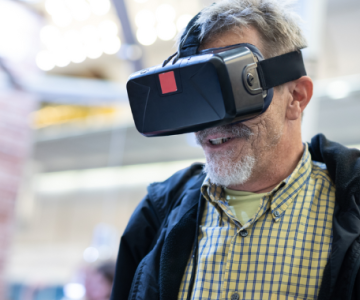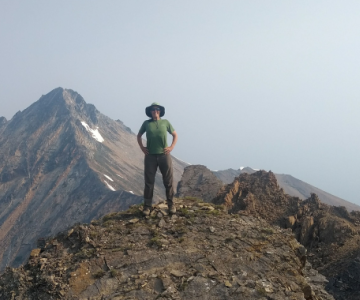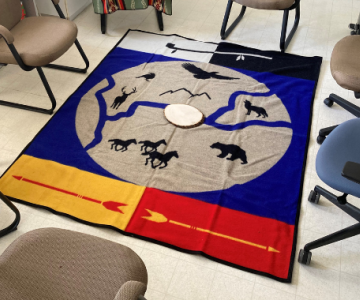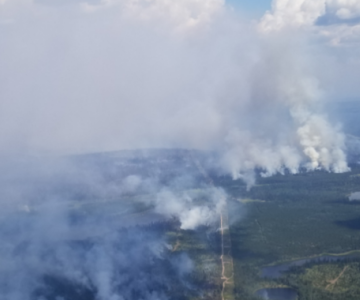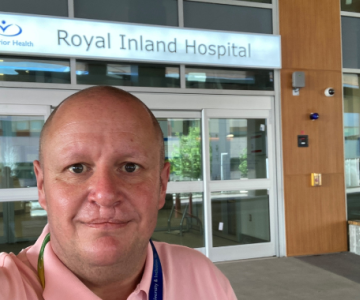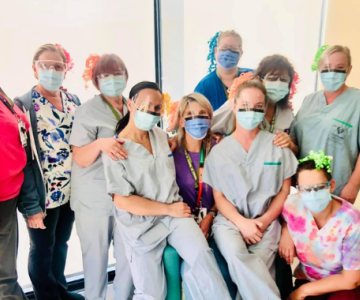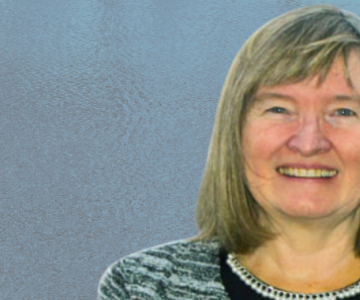Breadcrumb
Explore Stories
2 Minute Read
Research & Innovation
Cindy is 86, grew up in Kelowna, and over the years has enjoyed all kinds of outdoor activities like mountain climbing, water sports, and horseback riding. The many things that still bring her comfort and joy are children, music, gardens and, most of all, animals.
Cindy lives in a long-term care facility and, like many, faced the challenges of social isolation during the COVID-19 pandemic.
To combat this, the seniors care team at Interior Health has introduced a new tool that can be personalized in a meaningful way for older adults like Cindy – virtual reality. By wearing virtual reality goggles, seniors in our long-term care homes can view familiar and joyful content, which can be beneficial to their physical, mental and emotional health. It also helps health-care teams as they work to match care needs in a person-centred way.
Cindy now has the opportunity to immerse herself virtually in activities that she was previously accustomed to. Because she loves animals, the staff provides content for her that feed that love, in this case a herd of horses with some roaming toward her, close enough to feed.
Cindy interacts with a virtual horse
The familiarity of the virtual reality content is stimulating and invites Cindy to engage with what she’s viewing by physically reaching out as if she’s feeding one of the horses some hay. Her body language transforms in a positive and dynamic way as she does this, as she’s stimulated physically, mentally and emotionally.
“Our minds are complex and can be stimulated by such positive and meaningful interactions,” says Joanna Harrison, IH executive director of Seniors Specialized Care. “Technology will permeate our health system in ways we have never experienced before. This is one example of embracing the era of digital health.”
Having the technology is one thing. Measuring if it has a positive impact on seniors’ quality of life and overall health is another. So, caregivers will be watching those who use virtual reality for positive signs in their emotional well-being and behaviour. These might include increased eye contact, more appetite and interest in food, participating in more recreational programs, a reduction in falls, and whether they proactively engage in self-care, such as requesting to get their hair done.
Could this be the future of one aspect of seniors’ care? So far, health-care teams have seen many benefits and also have witnessed acceptance of technological advances.
“More often than not we limit options for others based on our preconceived perceptions, like older adults can’t use technology, let alone virtual reality,” adds Joanna. “It’s intentional person-centred care, and a team approach is best.”
3 Minute Read
Community & Culture
Dr. Ilona Hale, on a ridge above 12 Mile Creek near Golden.
Name: Dr. Ilona Hale (she/her/hers)Job Title: Family Physician ResearcherYears of Service: 25Worksite: Kimberley Medical ClinicCommunity: KimberleyAncestral Territory: KtunaxaAdvice to live by: "Walk with the dreamers, the believers, the courageous, the cheerful, the planners, the doers, the successful people with their heads in the clouds and their feet on the ground. Let their spirit ignite a fire within you to leave this world better than you found it..." - Wilferd Peterson
Dr. Ilona Hale is no stranger to small-town life – she was born and raised in the mining town of Lively in Northern Ontario. Now, Ilona is a rural family physician in Kimberley, as well as a clinician researcher.
“I’ve always considered it an amazing privilege to practice medicine – to have the opportunity to be part of peoples' lives every day, and share tools to help them, even if it’s in a small way. When I see people getting better, it makes me want to keep going.”
2 Minute Read
Health & Wellness
A healing circle
Everyone deserves to be heard, and to feel safe and understood, but it’s clear from the In Plain Sight Report this doesn’t always happen for members of B.C.’s Aboriginal communities.
The Report, released November 2020, provides 24 recommendations for addressing Indigenous-specific racism within the B.C. health-care system. Among them was the development of a strategy that would improve patient complaint processes and address that racism, which is both individual and systemic.
With this in mind, Interior Health saw a way to create a more culturally safe space for complaint resolution through its Patient Care Quality Office. That’s how Lucie Poisson and Natalie Daniels (pictured below) came to be new Aboriginal Patient Care Quality and Safety Consultants. Patients and clients who self identify as Aboriginal now have an option to be directed to Natalie and Lucie for direct follow-up.
Aboriginal Patient Care Quality and Safety Consultants: Lucie Poisson (left) and Natalie Daniels
"Something that came out of the In Plain Sight Report is that respondents didn't feel comfortable bringing their concerns forward, and one of the barriers to bringing concerns forward to an office such as ours is that people didn't feel their concerns were going to be taken seriously," says Natalie.
Interior Voices podcast host Tracy Mooney recently met with Lucie, Natalie, and Shari McKeown, IH’s Director for Patient Safety, to discuss the new positions, and how they will contribute to better and more culturally safe recourse for people’s concerns.
Culturally safe recourse means that a patient or client has control of how the resolution process looks. They might choose to submit their concern in writing, have a phone call, or meet in person. Or, they might request a healing circle, have family or friends present with them, or another restorative approach.
"When a client is stepping forward with a concern or a story or an experience to share, that feedback is a gift for us and it leads to an opportunity to improve our care and services and make them safe for everybody's use," says Shari.
As Interior Health continues to work to improve health care for all, these new positions provide a culturally safe space for Aboriginal patients and clients to share.
"It's critical for us to hear from people about their experiences, worries and challenges in receiving care, or the omission of care, so that we can start to reconcile and take action," says Lucie.
Learn more:
Interior Voices podcast
Interior Health Patient Care Quality Office
In Plain Sight Report and Recommendations
2 Minute Read
Community & Culture
Mother Nature is glorious but fickle – we never know what she is going to hand us.
Folks in the Chilcotin are known to be resourceful and resilient, but our mettle was significantly tested during the massive firestorm of 2017, when three major complexes - the Plateau, Hanceville and West Chilcotin - burned 8,193 square kilometres. During the 2021 fire season, this area was under threat again as two significant wildfires at Big Stick Lake and Hotnarko Creek kept people living along the Highway 20 corridor on high alert.
The West Chilcotin Health Centre is small, so we have to handle whatever walks through the door. The building has a generator that starts automatically when the power cuts to allow continuous care. We are equipped with radios to connect with the local Search and Rescue, various community repeater systems, a satellite phone and spot device with text-based communication, and a GPS location tied to our manager’s email should we need further emergency assistance. We stock bottled water and dry food along with a small warehouse of medical supplies in case our highway is shut down.
Wildfire in the Cariboo Regional District
During the 2017 wildfires, one of our biggest challenges was acquiring medications for patients while the highway was closed. Our nurse practitioner Patrice Gordon and I gathered information about what medications our patients needed; some patients are so remote they required visitation by horseback from Patrice. We called the prescriptions into a Shopper’s Drug Mart in Nanaimo and they flew the medications into Bella Coola, where the medications were picked up by the RCMP and driven to the clinic or the local manor, where I was assisting after hours making food for fire crews.
The thing that I always take away from any disaster is how important it is to be fluid: for our patients and for ourselves. We must keep adjusting to whatever changes are thrown at us each day. No two events will ever be the same. Being prepared is so very important but being able to adapt within that emergency will always be the biggest asset.
About the author
Lee Anne Wright provides administrative support as a health unit aide in Alexis Creek and Tatla Lake.
Natural Disaster Champions series
In 2021, the B.C. Interior region experienced a natural disaster season like none other. Interior Health staff stepped up and came together to support each other, patients, friends, family and communities. We’re sharing the stories of staff members reflecting on how being prepared – at home and at work – can make all the difference when minutes matter.
View more stories in the series
2 Minute Read
Community & Culture
Michelle cross-country skiing at Dawn Mountain
Name: Michelle Plenderleith (she/her/hers)Job Title: Operating Room Booking / Nursing Unit Clerk Years of Service: 7Worksite: Golden & District HospitalCommunity: GoldenAncestral Territory: KtunaxaAdvice to live by: Let go of the small things.
Michelle’s favourite things about her job are three-fold:
Her coworkers, including nurses, physicians, and medical device reprocessing, administration and housekeeping staff
The patients she has the opportunity to see and talk to, and helping them navigate the health-care system
How fast paced her role is, and that it changes day to day so it’s never boring
5 Minute Read
Community & Culture
Peter Renn, project manager with Interior Health Capital Planning & Projects, in front of the new Phil & Jennie Gaglardi Tower at Royal Inland Hospital in Kamloops.
When Peter Renn woke up from the second coma he had slipped into in two weeks, he was at Royal Inland Hospital (RIH) in Kamloops, disoriented, scared and, according to his physician, near death.
A Kamloops resident, Peter had cirrhosis of the liver, brought on by a rare, inherited disease. Without a transplant, he was told he would likely die.
It was 2018 and the end of a 10-year journey of visits to various hospitals. By his count, nine times he was close to death. However, this time, everything had gotten worse. Twice he slipped into a coma. Awake in RIH, he was disoriented and fearful for his life - scared of losing his wife and his two young children.
“At that point, I was rock bottom,” he says. “I didn’t know whether I would live or die.”
After he was transferred from the ICU, his care was supported by other Interior Health teams. First, a student nurse calmed his fears with compassion and caring. Like an angel, she asked him what his three wishes would be if he could have them. He replied that he wanted the feeding tube gone, he needed water and he wanted to return to his family.
2 Minute Read
Community & Culture
Brookhaven's Chronic Behavioural Disorder unit staff celebrate a resident's 80th birthday while evacuated at Creekstone Manor in North Vancouver in August 2021.
In August 2021, the Brookhaven Care Centre team in West Kelowna came together in extraordinary measures to safely evacuate all 104 of their residents from the risk of wildfire.
Residents boarded a series of buses, then an airplane, to arrive at their destinations in Vancouver. Several staff accompanied the residents on the journey, a few working continuously for 24 hours to ensure everyone was safe and settled into their temporary homes. One dedicated health-care aide even slept on the floor of the nursing unit the first night, keeping close by in case his residents needed him.
Pam Gill, LPN (left) and Keegan Dufresne, Long-Term Care Aide
A number of team members continued to live on-site with the residents, while others travelled back and forth between the Interior and the coast for a number of weeks. The efforts staff put in to make the best of the experience were incredible. They took time to decorate the residents’ bedrooms with posters and comfort items, and even hosted an 80th birthday party and 60th wedding anniversary celebration. These staff gave all their love and attention to their residents while being separated from their own homes and families.
The staff who stayed behind were no less dedicated, taking great care in cleaning the site top to bottom and preparing everything for the happy return of their residents.
A triumphant return for Brookhaven Care Centre staff member Tana (top) and resident Mary.
“I am constantly inspired by the incredible team that we have at Brookhaven, and how much they genuinely care about their residents,” said Renee Gauthier, Manager, Clinical Operations.
“It is because of their compassion and dedication that our vulnerable seniors were kept safe from greater distress during this emergency situation. While there were bumps and lessons learned, the competence, collaboration and humour of this team was commendable at every step of the way. I am so very proud of them!”
Renee Gauthier, Manager, Clinical Operations, Brookhaven Care Centre is constantly inspired by the Brookhaven team.
Natural Disaster Champions series
In 2021, the B.C. Interior region experienced a natural disaster season like none other. Interior Health staff stepped up and came together to support each other, patients, friends, family and communities. We’re sharing the stories of staff members reflecting on how being prepared – at home and at work – can make all the difference when minutes matter.
View more stories in the series
2 Minute Read
Community & Culture
More than 50 years ago, police raided the Stonewall Inn, and demanded sex verification checks on the patrons. A spontaneous protest broke out that helped to spread the conversation about lesbian, gay, bisexual, transgender, queer and/or questioning, intersex, asexual, and Two-Spirit people (LGBTQIA2S+) issues and the battle for acceptance and inclusion. It was also the start of what today we celebrate as Pride.
Pride is an opportunity to recognize the impact of lesbian, gay, bisexual, transgender, queer and/or questioning, intersex, asexual, and Two-Spirit people in our communities.
Become an ally to contribute to the elimination of racism and discrimination. An ally is someone who:
Addresses the issue, not just the incident
Is willing to take risks and speak up
Is visible, active, vigilant, and public (even when the target person is not in the room)
Is willing to recognize the inherent privilege and power of being a member of the dominant group
Views their own membership in the dominant group as an opportunity to bring about change
Is proactive more often than reactive
Is always intentional, overt, vocal, consistent, and public about being an ally (allies aren't silent)
Join us in celebrating Pride, not only this month, but throughout the year - as allies with LGBTQIA2S+ people everywhere.
Learn more:
Being an LGBTQ2+ Ally (Government of Canada School of Public Service
Commemorate 50 Inclusivity Toolkit (Government House of BC)
Canadian Centre for Diversity and Inclusion
The Arquives: Canada’s LGBTQ2+ Archives
2 Minute Read
Community & Culture
Name: Dr. Sue MacDonaldJob Title: Executive Medical DirectorYears of Service: 7Worksite: Kelowna Community Health CentreCommunity: KelownaAncestral Territory: Syilx
Later this summer, Dr. Sue MacDonald will retire from her role as Executive Medical Director with Interior Health. IH Aboriginal Partnerships recently recognized Dr. MacDonald for her ongoing commitment and medical leadership in support of improving Aboriginal Health outcomes and access to culturally safe care.
-
Load More
Showing 333 of 677
STAY CONNECTED
Receive news and alert posts, and Stories@IH blog posts, right to your inbox!

